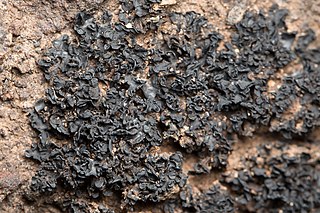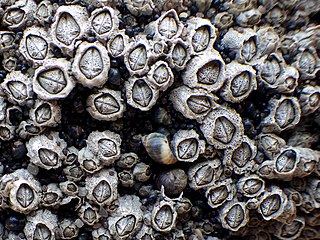
The Roccellaceae are a family of fungi in the order Arthoniomycetes. Most taxa are lichenized with green algae, although some are lichenicolous, growing on other lichens.

The Lichinaceae are a family of ascomycete fungi. Most species are lichenized with cyanobacteria, and have a distribution largely in temperate regions.

The Baeomycetales are an order of mostly lichen-forming fungi in the subclass Ostropomycetidae, in the class Lecanoromycetes. It contains 8 families, 33 genera and about 170 species. As a result of molecular phylogenetics research published in the late 2010s, several orders were folded into the Baeomycetales, resulting in a substantial increase in the number of taxa.

Ochrolechia is a genus of crustose lichens in the family Ochrolechiaceae.

Lecania is a genus of lichenized fungi in the family Ramalinaceae. The genus was circumscribed by Abramo Bartolommeo Massalongo in 1853. Lecania is widely distributed, especially in temperate regions, and contains about 64 species.

Protopannaria is a genus of seven species of lichenized fungi in the family Pannariaceae. The genus was originally circumscribed as a subgenus of the genus Pannaria by Hungarian lichenologist Vilmos Kőfaragó-Gyelnik. Per Magnus Jørgensen and Stefan Ekman promoted Protopannaria to full status as a genus in 2000.

Thelotrema is a genus of lichen-forming fungi in the family Graphidaceae, the family to which all taxa in the former Thelotremataceae now belong.

Amandinea is a genus of lichenized fungi in the family Caliciaceae. Genetic studies indicates that the genus Amandinea and Buellia are the same, although this is not widely accepted.

Arthothelium is a genus of lichenized fungi in the family Arthoniaceae.

Chiodecton is a genus of lichens in the family Roccellaceae. The genus was circumscribed by lichenologist Erik Acharius in 1814, with Chiodecton sphaerale assigned as the type species.

Enterographa is a genus of lichens in the family Roccellaceae.

Collemopsidium is a genus of fungi in the family Xanthopyreniaceae. Some members of this genus are marine species, and described as "borderline lichens" or "algicolous" fungi. The genus was circumscribed by Finnish botanist William Nylander in 1881.
Zahlbrucknerella is a genus of filamentous, rock-dwelling lichens in the family Lichinaceae.

Tephromela is a genus of lichens in the family Tephromelataceae. There are about 25 species in this widespread genus.
Ducatina is a genus of umbilicate lichen in the family Trapeliaceae. It is monotypic, containing the single species Ducatina umbilicata. Both the genus and species were described as new to science in 2017 by Damien Ertz and Ulrik Søchting. The lichen is widespread and abundant in the remote subantarctic Crozet and Kerguelen Islands in the Indian Ocean, where it grows on the exposed horizontal surfaces of rocks. According to the authors, the thallus morphology is "reminiscent of a weathered metal coin "; the name Ducatina, derived from the word ducatus, refers to this.
Trimmatothele is a genus of saxicolous (rock-dwelling), crustose lichens in the family Verrucariaceae. It has five species. The genus was formally published by lichenologist Alexander Zahlbruckner in 1903. The type species, Trimmatothele perquisita, was originally collected from Norway by Johannes M. Norman, who placed it in the genus Coniothele in 1868. Diagnostic characteristics of Trimmatothele include a thin thallus with a smooth surface; small perithecia that are partially immersed in the substrata and have an involucrellum; asci that contain multiple ascospores; and small, simple ascospores. Trimmatothele has been described as one of the most poorly known genera of lichens due to the rarity of its species, the few available herbarium specimens, and some missing type specimens.
Koerberiaceae is a small family of lichen-forming fungi in the order Peltigerales. It contains 3 genera and 9 species. The family was proposed by Toby Spribille and Lucia Muggia in 2012, after molecular phylogenetic analysis revealed the existence of three lineages of lichen-forming fungi in the suborder Peltigerineae of the order Peltigerales. The lineages represented the genera Steinera, Koerberia, and Vestergrenopsis. The latter genus was later folded into synonymy with Tingiopsidium.
Henssenia is a genus of lichen-forming fungi in the family Koerberiaceae. It has four species. The genus was circumscribed in 2017 by Damien Ertz, Roar Skovlund Poulsen, and Ulrik Søchting, with Henssenia glaucella assigned as the type species. The main distinguishing characteristic of the genus is simple ascospores that sometimes have a plasma bridge. The genus name honours German lichenologist Aino Henssen.













